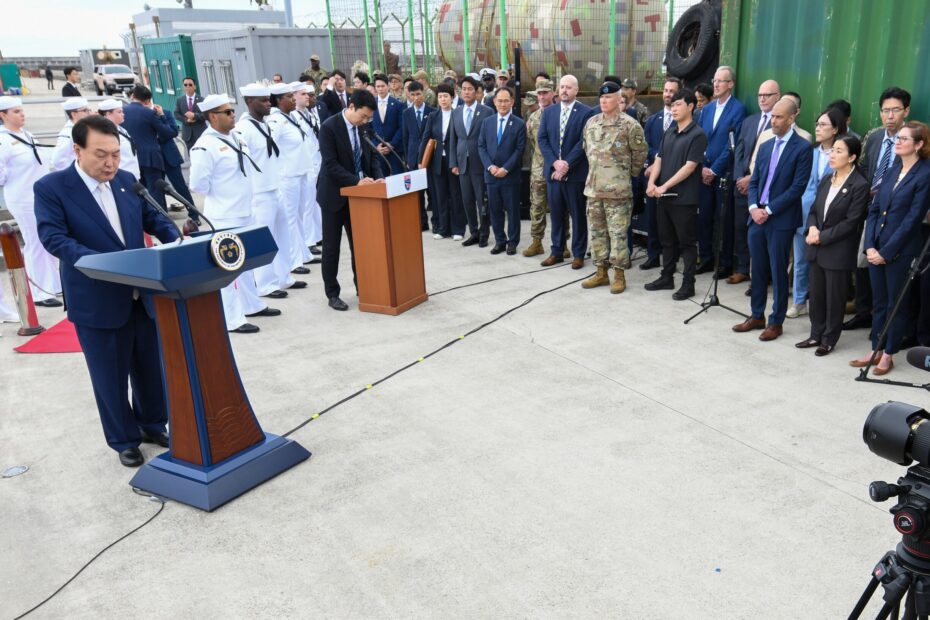Republic of Korea President Yoon Suk Yeol delivers remarks during a visit to the Ohio-class ballistic-missile submarine USS Kentucky (SSBN 737) on 19th July 2023 (Photo by US Navy/Mass Communication Specialist 1st Class Michael Chen)
An op-ed by Jihoon Yu
The Republic of South Korea (ROK) has an ambition to develop and acquire nuclear-powered submarines (termed as SSNs as per the US hull classification) which has ignited considerable debate among defense analysts and policymakers. While some critics perceive this move as an unnecessary escalation in an already volatile regional environment, a thorough examination reveals that ROK’s SSN program is far from superfluous. It is, in fact, a strategic necessity that substantially enhances the cohesion and effectiveness of the ROK-US alliance, as well as Seoul’s overall defense posture.
This op-ed elaborates this point further by underlining the various aspects.
South Korea’s strategic position in East Asia places it at the nexus of several critical regional rivalries. The shifting dynamics with North Korea, coupled with the growing strategic competition between the United States and China, underscore the importance of strengthening South Korea’s defense capabilities. The Korean Peninsula has long been a flashpoint due to North Korea’s aggressive posture and military advancements. In recent years, North Korea’s ballistic missile technology has made significant strides, and its expanding naval capabilities, including the development of submarines capable of launching ballistic missiles, present increasingly sophisticated security challenges. The need for South Korea to bolster its maritime defense infrastructure is thus underscored by these advancements, which highlight the importance of a robust response capability to counter such threats effectively.
The acquisition of SSNs represents a major upgrade in South Korea’s maritime capabilities. Unlike conventional diesel-electric submarines, which have inherent limitations in endurance and stealth due to their need to surface periodically for fuel and air, SSNs offer substantial operational advantages. Their nuclear propulsion systems allow them to operate submerged for extended periods without the need for frequent surfacing, thereby providing a significant edge in terms of stealth, endurance, and operational flexibility. This capability allows South Korean submarines to maintain a covert presence, conduct extended patrols, and engage in complex intelligence-gathering missions. These enhanced capabilities are crucial for monitoring North Korean activities, conducting surveillance, and responding to potential provocations from Pyongyang in a more timely and effective manner. By possessing SSNs, South Korea ensures that it can maintain a persistent and discreet maritime presence, significantly augmenting its strategic options.
Furthermore, the SSN program aligns seamlessly with the strategic objectives of the ROK-US alliance, which has been a cornerstone of regional stability and security. The alliance has been instrumental in maintaining a unified front against common threats and ensuring stability in the region. South Korea’s investment in SSNs not only bolsters its own defensive capabilities but also strengthens the synergy between South Korean and American naval forces. The integration of South Korean SSNs with US nuclear submarines facilitates enhanced intelligence sharing and operational coordination. This interoperability streamlines joint operations, enabling both nations to execute effective deterrence and defense strategies more efficiently. The ability to operate in concert with US naval forces ensures that both Seoul and Washington DC can present a cohesive and formidable maritime defense posture, reinforcing their collective security interests.
By developing its own SSNs, South Korea also plays a crucial role in distributing the operational burden within the alliance more equitably. This move helps reduce the strain on US naval assets, allowing American forces to be allocated to other strategic priorities and operational needs. The redistribution of responsibilities optimises the overall effectiveness of the allied naval presence, ensuring that resources are utilised where they are most needed. Furthermore, the SSN program enables South Korea to assume a more proactive role in regional maritime security, contributing to a more balanced alliance where both partners share the responsibility for maintaining regional defense. This increased responsibility allows South Korea to not only bolster its own security but also contribute more meaningfully to collective regional stability in the wake of AUKUS and QUAD collaboration.
Critics may argue that South Korea’s SSN program could exacerbate regional tensions or contribute to an arms race. However, this perspective fails to account for the primary defensive nature of the SSNs. The program is designed to enhance South Korea’s defensive posture, not to provoke conflict. By investing in advanced submarine technology, South Korea aims to better protect its national interests and contribute to regional stability. The collaborative effort with the US in developing and integrating SSNs also introduces mechanisms for transparency and confidence-building. Through joint exercises, shared operational practices, and strategic coordination, both nations can mitigate the risks of misunderstandings and miscalculations, thereby fostering greater stability in the region. Such measures can include regular communication and coordination with neighboring countries, as well as participation in multilateral security dialogues to reinforce the non-threatening nature of South Korea’s SSN capabilities.
In conclusion, South Korea’s pursuit of an SSN program is a strategically astute decision that significantly reinforces both its national defense capabilities and the overall effectiveness of the ROK-US alliance. By advancing its maritime capabilities, South Korea not only enhances its own security posture but also contributes to the broader goal of regional stability and security. The SSN program serves as a prime example of how regional allies can leverage advanced technology and collaborative strategies to address complex security challenges. It underscores the importance of maintaining a robust and integrated defense framework in an increasingly volatile geopolitical landscape. Through this initiative, South Korea demonstrates its commitment to both its national security and its pivotal role within the alliance, thereby contributing to a more stable and secure East Asian region. As the geopolitical environment continues to evolve, South Korea’s strategic investment in SSNs represents a forward-looking approach that strengthens both its national defense and its partnership with the United States, ultimately supporting a balanced and stable regional security architecture.
About Jihoon Yu
Jihoon Yu is a research fellow at the Korea Institute for Defense Analyses. He served in the ROK Navy for 27 years, with experience as both a surface and submarine officer. He was a member of Task Forces for South Korea’s light aircraft carrier project and Jangbogo-III submarine project. He is the main author of the ROK Navy’s Navy Vision 2045. His area of expertise includes the ROK-US alliance, the ROK-Europe security cooperation, Inter-Korean relations, national security, maritime security, hybrid-threats and strategic weapons systems. He earned his BA in International Relations from the ROK Naval Academy, MA in National Security Affairs from the US Naval Postgraduate School and PhD in Political Science from Syracuse University.





